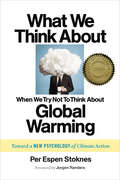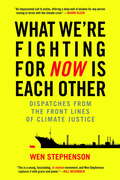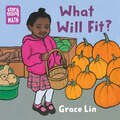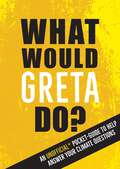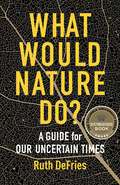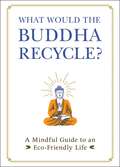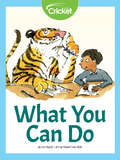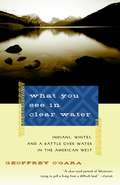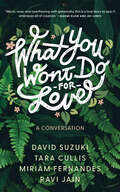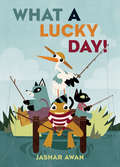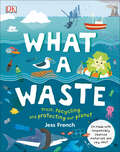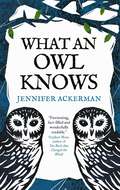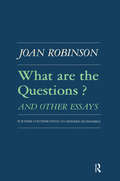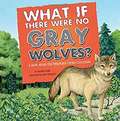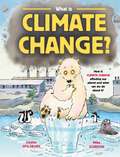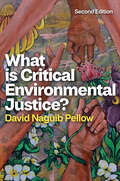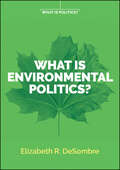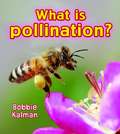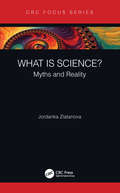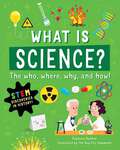- Table View
- List View
What We Think About When We Try Not To Think About Global Warming: Toward a New Psychology of Climate Action
by Per Espen StoknesWhy does knowing more mean believing—and doing—less? A prescription for changeThe more facts that pile up about global warming, the greater the resistance to them grows, making it harder to enact measures to reduce greenhouse gas emissions and prepare communities for the inevitable change ahead.It is a catch-22 that starts, says psychologist and economist Per Espen Stoknes, from an inadequate understanding of the way most humans think, act, and live in the world around them. With dozens of examples—from the private sector to government agencies—Stoknes shows how to retell the story of climate change and, at the same time, create positive, meaningful actions that can be supported even by deniers.In What We Think About When We Try Not To Think About Global Warming, Stoknes not only masterfully identifies the five main psychological barriers to climate action, but addresses them with five strategies for how to talk about global warming in a way that creates action and solutions, not further inaction and despair.These strategies work with, rather than against, human nature. They are social, positive, and simple—making climate-friendly behaviors easy and convenient. They are also story-based, to help add meaning and create community, and include the use of signals, or indicators, to gauge feedback and be constantly responsive.Whether you are working on the front lines of the climate issue, immersed in the science, trying to make policy or educate the public, or just an average person trying to make sense of the cognitive dissonance or grapple with frustration over this looming issue, What We Think About When We Try Not To Think About Global Warming moves beyond the psychological barriers that block progress and opens new doorways to social and personal transformation.
What We're Fighting for Now Is Each Other
by Wen StephensonAn urgent, on-the-ground look at some of the "new American radicals" who have laid everything on the line to build a stronger climate justice movementThe science is clear: catastrophic climate change, by any humane definition, is upon us. At the same time, the fossil-fuel industry has doubled down, economically and politically, on business as usual. We face an unprecedented situation--a radical situation. As an individual of conscience, how will you respond?In 2010, journalist Wen Stephenson woke up to the true scale and urgency of the catastrophe bearing down on humanity, starting with the poorest and most vulnerable everywhere, and confronted what he calls "the spiritual crisis at the heart of the climate crisis." Inspired by others who refused to retreat into various forms of denial and fatalism, he walked away from his career in mainstream media and became an activist, joining those working to build a transformative movement for climate justice in America.In What We're Fighting for Now Is Each Other, Stephenson tells his own story and offers an up-close, on-the-ground look at some of the remarkable and courageous people--those he calls "new American radicals"--who have laid everything on the line to build and inspire this fast-growing movement: old-school environmentalists and young climate-justice organizers, frontline community leaders and Texas tar-sands blockaders, Quakers and college students, evangelicals and Occupiers. Most important, Stephenson pushes beyond easy labels to understand who these people really are, what drives them, and what they're ultimately fighting for. He argues that the movement is less like environmentalism as we know it and more like the great human-rights and social-justice struggles of the nineteenth and twentieth centuries, from abolitionism to civil rights. It's a movement for human solidarity.This is a fiercely urgent and profoundly spiritual journey into the climate-justice movement at a critical moment--in search of what climate justice, at this late hour, might yet mean.From the Hardcover edition.
What Will Fit? (Storytelling Math)
by Grace LinCaldecott Honor winner Grace Lin celebrates math for every kid, everywhere!Take a trip to the farmers' market in this playful story about spatial sense. Olivia is searching for something just the right size to fill her basket. The apple is so small that it rolls around. The zucchini is so long that it sticks out. What will fit just right? Storytelling Math celebrates children using math in their daily adventures as they play, build, and discover the world around them. Joyful stories and hands-on activities make it easy for kids and their grown-ups to explore everyday math together. Developed in collaboration with math experts at STEM education nonprofit TERC, under a grant from the Heising-Simons Foundation.
What Would Greta Do?: An Unofficial Pocket Guide to Help Answer Your Climate Questions
by Summersdale PublishersFrom your first steps toward living sustainably all the way to going zero-waste, this book is here to help you find solutions to all your climate conundrums by taking inspiration from a true eco-warrior. If we each approach the climate emergency in the same way as Greta, we can all live a planet-friendly life and enjoy a brighter future.
What Would Greta Do?: An Unofficial Pocket Guide to Help Answer Your Climate Questions
by Summersdale PublishersFrom your first steps toward living sustainably all the way to going zero-waste, this book is here to help you find solutions to all your climate conundrums by taking inspiration from a true eco-warrior. If we each approach the climate emergency in the same way as Greta, we can all live a planet-friendly life and enjoy a brighter future.
What Would Nature Do?: A Guide for Our Uncertain Times
by Ruth DeFriesNot long ago, the future seemed predictable. Now, certainty about the course of civilization has given way to fear and doubt. Raging fires, ravaging storms, political upheavals, financial collapse, and deadly pandemics lie ahead—or are already here. The world feels less comprehensible and more dangerous, and no one, from individuals to businesses and governments, knows how to navigate the path forward.Ruth DeFries argues that a surprising set of time-tested strategies from the natural world can help humanity weather these crises. Through trial and error over the eons, life has evolved astonishing and counterintuitive tricks in order to survive. DeFries details how a handful of fundamental strategies—investments in diversity, redundancy over efficiency, self-correcting feedbacks, and decisions based on bottom-up knowledge—enable life to persist through unpredictable, sudden shocks. Lessons for supply chains from a leaf’s intricate network of veins and stock market-saving “circuit breakers” patterned on planetary cycles reveal the power of these approaches for modern life. With humility and willingness to apply nature’s experience to our human-constructed world, DeFries demonstrates, we can withstand uncertain and perilous times. Exploring the lessons that life on Earth can teach us about coping with complexity, What Would Nature Do? offers timely options for civilization to reorganize for a safe and prosperous future.
What Would the Buddha Recycle?
by Rosemary RobertsIf the Buddha were alive today, he'd be the living embodiment of green living. He'd be collecting cans on the freeway, riding his bike to work, and replacing all his light bulbs--one little satori at a time. In this book you can channel His Holiness, reduce your footprint, and experience little Aha! moments when you Eat mindfully and lose the meat Make a Zen garden that nourishes the earth Choose sustainable clothing Meditate while walking instead of driving Let go of attachment to things by giving away belongings Living green is living Zen. Now you can take right action and walk a green talk, starting today--just think how proud the Buddha would be!
What Would the Buddha Recycle?: A Mindful Guide to an Eco-Friendly Life
by Adams MediaLive the calm and eco-friendly lifestyle you&’ve always dreamed of with this perfect guide to eco-conscious living for anyone who wants to save the planet and make a difference. In today&’s world, there is a lot that can stress us out. We live in a time when talking about climate change is a hot button issue leading to political movements, youth led protests, and lots of anxiety. From green living to figuring out how you (and your family) can make a difference in your community, this mindful approach is the key to being stress-free as you make a positive impact on the environment. What Would the Buddha Recycle? can help you gain a better understanding of how you impact the world around you in your day-to-day life. And, even better, it can help you pause, reflect, and figure out what changes you can make to protect the world. In this book you&’ll learn how to: -Use natural ingredients in your home for cleaning (lemon juice can help your furniture shine) and pest control (chili pepper can deter ants) -Combine mindful cooking and eating for healthier meals that don&’t hurt the environment and make you feel great -Figure out the right food to keep your beloved pets happy and healthy by choosing natural ingredients and avoiding chemical preservatives -Include your family in your new environmentally friendly ways and raise your children to have a similar mindset about saving the planet -And much more! With advice that covers every area of your daily life, What Would the Buddha Recycle? offers easy changes so you can make a difference and protect the environment all while staying zen in the process.
What Would the Buddha Recycle?: The Zen of Green Living
by Rosemary RobertsIf the Buddha were alive today, he'd be the living embodiment of green living. He'd be collecting cans on the freeway, riding his bike to work, and replacing all his light bulbs one little satori at a time. In this book you can channel His Holiness, reduce your footprint, and experience little Aha! moments when you: - Eat mindfully and lose the meat - Make a Zen garden that nourishes the earth - Choose sustainable clothing - Meditate while walking instead of driving - Let go of attachment to things by giving away belongings Living green is living Zen. Now you can take right action and walk a green talk, starting today -- just think how proud the Buddha would be!
What You Can Do
by Liz HuyckPlants and animals need our help! All over the world, they are in trouble. Find out some ways to help by changing the way you interact with them and their environment.
What You See in Clear Water: Live on the Wind River Reservation (Vintage Departures)
by Geoffrey O'GaraThe Wind River runs from the alpine lakes of the Continental Divide through the nestled valleys of the northern Rocky Mountains and out onto high, windblown plains. More than a century ago, in what would become Wyoming, the federal government set aside 44 million acres on which to confine the unrelated Shoshone and Arapaho tribes. By now the Wind River Reservation has been reduced to 2.3 million acres, but the battle over control of this land--and especially the river that runs through it--is far from over.In this magnificent watershed, Geoffrey O'Gara--"a touching, wise, and penetrating writer," according to Edward Hoagland--sets a remarkable story that illuminates the larger, unfinished struggle for the heart of the West. He ranges from the Indian wars to the present day, and from the nineteenth-century Shoshone chief Washakie to his great-grandson, now head of the tribal council; and he also traces the complex legal struggle over water rights--for generations monopolized by white farmers for irrigation--that after two decades is still unresolved. At the heart of O'Gara's account are the citizens of Wind River itself, the people on the various sides of the many complex conflicts: the tragedy and resilience of the nine thousand Shoshone and Arapaho contending with the depredations of reservation life and the indifference of those who first took their land and have gradually assumed control of their water.In all, this is a powerful, moving story of great relevance and guarded promise, of nations with different languages, cultures, and birthrights, still searching for a way to live together.From the Hardcover edition.
What You Won’t Do For Love: A Conversation
by David Suzuki Ravi Jain Tara Cullis Miriam FernandesWhat if we could love the planet as much as we love one another? "Warm, wise, and overflowing with generosity, this is a love story so epic it embraces all of creation. Yet another reminder of how blessed we are to be in the struggle with elders like David and Tara.” – Naomi Klein and Avi Lewis What You Won’t Do for Love is an inspiring conversation about love and the environment. When artist Miriam Fernandes approaches the legendary eco-pioneer David Suzuki to create a theatre piece about climate change, she expects to write about David’s perspective as a scientist. Instead, she discovers the boundless vision and efforts of Tara Cullis, a literature scholar, climate organizer, and David’s life partner. Miriam realizes that David and Tara’s decades-long love for each other, and for family and friends, has only clarified and strengthened their resolve to fight for the planet. What You Won’t Do for Love transforms real-life conversations between David, Tara, Miriam, and her husband Sturla into a charmingly novel and poetic work. Over one idyllic day in British Columbia, Miriam and Sturla take in a lifetime of David and Tara’s adventures, inspiration, and love, and in turn reflect on their own relationships to each other and the planet. Revealing David Suzuki and Tara Cullis in an affable, conversational, and often comedic light, What You Won’t Do For Love asks if we can love our planet the same way we love one another.
What a Lucky Day!
by Jashar AwanOH NO! BAD LUCK! A black cat crossed my path! I won’t catch anything today! Four animals are off to the lake to go fishing, but each thinks the other will wreck their day. Raccoons are thieves. Frogs give you warts. Storks deliver babies. Wait. What? Where did these crazy ideas come from? As this wryly humorous and thoroughly satisfying tale shows, it’s a mistake to judge others on what you’ve heard—and there’s plenty of luck for everyone.
What a Mushroom Lives For: Matsutake and the Worlds They Make
by Michael J. HathawayHow the prized matsutake mushroom is remaking human communities in China—and providing new ways to understand human and more-than-human worldsWhat a Mushroom Lives For pushes today’s mushroom renaissance in compelling new directions. For centuries, Western science has promoted a human- and animal-centric framework of what counts as action, agency, movement, and behavior. But, as Michael Hathaway shows, the world-making capacities of mushrooms radically challenge this orthodoxy by revealing the lively dynamism of all forms of life.The book tells the fascinating story of one particularly prized species, the matsutake, and the astonishing ways it is silently yet powerfully shaping worlds, from the Tibetan plateau to the mushrooms’ final destination in Japan. Many Tibetan and Yi people have dedicated their lives to picking and selling this mushroom—a delicacy that drives a multibillion-dollar global trade network and that still grows only in the wild, despite scientists’ intensive efforts to cultivate it in urban labs. But this is far from a simple story of humans exploiting a passive, edible commodity. Rather, the book reveals the complex, symbiotic ways that mushrooms, plants, humans, and other animals interact. It explores how the world looks to the mushrooms, as well as to the people who have grown rich harvesting them.A surprise-filled journey into science and human culture, this exciting and provocative book shows how fungi shape our planet and our lives in strange, diverse, and often unimaginable ways.
What a Waste: Trash, Recycling, and Protecting our Planet (Protect the Planet)
by Jess FrenchIn this informative book on recycling for children, you will find everything you need to know about our environment. The good, the bad and the incredibly innovative. From pollution and litter to renewable energy and plastic recycling.This educational book will teach young budding ecologists about how our actions affect planet Earth and the big impact we can make by the little things we do.Did you know that every single plastic toothbrush ever made still exists? Or that there is a floating mass of trash larger than the USA drifting around the Pacific Ocean?It is not all bad news though. While this is a knowledge book that explains where we are going wrong, What a Waste also shows what we are getting right! Discover plans to save our seas. How countries are implementing green projects worldwide, and how to turn waste into something useful. The tiniest everyday changes can make all the difference to ensure our beautiful planet stays lush and teeming with life. It is a lively kid&’s educational book with fabulous illustrations and fun facts about the world broken into easy to digest bite-sized bits. Each page can be looked at in short bursts or longer reads for more detail, making it a great children&’s book for a range of age groups.Get Involved - Make A Difference!Almost everything we do creates waste, from litter and leftovers to factory gases and old gadgets. Find out where it goes, how it affects our planet and what we can do to reduce the problem. From how to make your home more energy and water efficient, to which items can be recycled and tips for grocery shopping, this book is packed full of ideas on how you can get involved to make our planet a better place to live.This environment book for children has a wealth of ideas for becoming a planet-defending hero:- Discover shocking facts about the waste we produce and where it goes- Learn where about our Earth&’s limited resources and how to take some pressure off- Your trash is another man&’s treasure- Small changes to take your home from wasteful to super resource efficient- Dive into saving our oceans and super recycling- And much, much moreWhat a Waste is one of several nature books for kids written by Jess French, a passionate conservationist and veterinarian committed to protecting the beautiful world we live in.
What an Owl Knows: The New Science of the World's Most Enigmatic Birds
by Jennifer Ackerman*THE NEW YORK TIMES BESTSELLER* &‘And if anyone knows anything about anything…it's Owl who knows something about something.&’ Winnie-the-Pooh, A. A. Milne From prehistoric cave paintings to the prints and etchings of Picasso, owls have captivated and inspired us for millennia. Whether they appear as ancient Athenian symbols of wisdom, ghostly harbingers of death, or the cuddly sidekicks of Harry Potter and Winnie the Pooh, these birds have continued to fascinate and disturb us in equal measure. Through revelatory new behavioural research, Jennifer Ackerman provides an intimate glimpse into these magnificent creatures&’ lives. From the evolutionary quirks behind their silent flight and rotating heads, to their romantic relationships and parenting styles, What an Owl Knows brings the rich natural history of owls to life. Deftly weaving together science and art, Ackerman journeys into the owl&’s moonlit world and asks: what is it about these birds that so enthrals us?
What are the Questions and Other Essays: Further Contributions to Modern Economics
by Robert K RobinsonA study of environmental degradation, this work presents the environmental problems of South Korea. The effects of rapid industrialisation and modernisation are documented along with the choices and actions which are available to the country.
What if There Were No Gray Wolves: A Book About The Temperate Forest Ecosystem (Food Chain Reactions)
by Suzanne Buckingham SladeDeciduous forest ecosystems can be found on nearly every continent. Countless animals and plants live in them. So what difference could the loss of one animal species make? Follow the chain reaction, and discover how important gray wolves are.
What is Climate Change?
by Louise SpilsburyEverything you need to know about climate change from the causes to the evidence to the effects and what you can do to help combat it.Climate change is already having dramatic and dangerous effects on life on Earth. But what does climate change really mean? What are people doing that could cause the whole planet to get warmer? How can simply driving a car or eating a burger end up impacting Earth's climate? From fossil fuels and deforestation to car use and cow farts, we uncover the culprits of climate change and work out what can be done to combat it.Scientists, inventors and technicians are coming up with creative solutions to try to reduce the effects of climate change, such as building floating homes, restoring flood plans and conserving water.We show how proactive and inspiring people are taking action around the world from campaigning to making practical changes to their everyday lives, and you can find out what you can do to help too.
What is Critical Environmental Justice?
by David Naguib PellowHuman societies have always been deeply interconnected with our ecosystems, but today those relationships are witnessing greater frictions, tensions, and harms than ever before. These dynamics mirror those experienced by marginalized communities across the planet, but they also provide a foundation for transformative thinking and action to address these challenges. In this updated edition of his innovative contribution, David Naguib Pellow introduces a new framework for critically analyzing Environmental Justice scholarship and activism. In doing so he extends the field’s focus to topics not usually associated with environmental justice, including policing, incarceration, the Israel/Palestine conflict, and the Black Lives Matter movement. In doing so he reveals that ecological violence is first and foremost a form of social violence, driven by and legitimated by social structures and discourses. He enriches this radical approach to Environmental Justice by drawing on Indigenous Studies, the Black Radical Tradition, Disability Studies, Queer and Transgender Studies, and Multi-Species Justice, among others. Those already familiar with the discipline will find themselves invited to think about the subject in entirely new ways. This book is a vital resource for students, scholars, and policy makers interested in innovative approaches to one of the greatest challenges facing humanity and the planet.
What is Environmental Politics? (Wiley Essential Clinical Guides to Understanding and Treating Issues of Child Mental Health)
by Elizabeth R. DeSombreWhy is it so difficult to control, or fix, pollution? How can we justify harvesting the world’s natural resources at unsustainable rates, even though these activities cause known harm to both people and ecosystems? Scientific knowledge and technological advances alone cannot tackle these environmental challenges; they also involve difficult political choices and trade-offs both locally and globally. What is Environmental Politics? introduces students to the different ways society attempts to deal with the political decisions needed to prevent or recover from environmental damage. Across its six chapters leading environmental scholar Elizabeth DeSombre explains what makes environmental problems, such as climate change, overfishing or deforestation, particularly challenging to address via political processes, what types of political structures are more or less likely to prioritize protecting the environment, and how effective political intervention can improve environmental conditions and the lives of people who depend on them.It will be a vital resource for students new to the field of environmental politics as well as readers interested in protecting the future of our planet.
What is Environmental Sociology? (What is Sociology?)
by Diana StuartGiven the escalating and existential nature of our current environmental crises, environmental sociology has never mattered more. We now face global environmental threats, such as climate change and biodiversity loss, as well as local threats, such as pollution and household toxins. The complex interactions of such pervasive problems demand an understanding of the social nature of environmental impacts, the underlying drivers of these impacts, and the range of possible solutions. Environmental sociologists continue to make indispensable contributions to this crucial task. This compact book introduces environmental sociology and emphasizes how environmental sociologists do “public sociology,” that is, work with broad public application. Using a diversity of theoretical approaches and research methods, environmental sociologists continue to give marginalized people a voice, identify the systemic drivers of our environmental crises, and evaluate solutions. Diana Stuart shines a light on this work and gives readers insight into applying the tools of environmental sociology to minimize impacts and create a more sustainable and just world.
What is Pollination? (Big Science Ideas #13)
by Bobbie KalmanPollination by insects is a critical function of all land ecosystems. Most orchard fruits, vegetables, and some field crops are pollinated by insects. This book features photographs that focus on the critical fact that protecting pollinators means having food to eat. It helps children look at insects in a different way. <P><P>Lexile Measure: 830
What is Science?: Myths and Reality
by Jordanka ZlatanovaIn a multitude of ways, science affects the life of almost every person on earth. From medicine and nutrition to communication and transportation, the products of scientific research have changed human life. These changes have mostly taken place in the last two centuries, so rapidly that the average person is unable to keep informed. A consequence of this "information gap" has been the increasing suspicion of science and scientists. The lack of true understanding of science, especially of "fundamental" research, motivates this effort to narrow this gap by explaining scientific endeavor and the data-driven worldviews of scientists. Key Features Fills an existing void in the understanding of science among the general population Is written in a nontechnical language to facilitate understanding Covers a wide range of science-related subjects: The value of "basic research" How scientists work by sharing results and ideas How science is funded by governments and private entities Addresses the possible dangers of research and how society deals with such risks Expresses the viewpoint of an author with extensive experience working in laboratories all over the world
What is Science?: The Who, Where, Why, and How
by Frances DurkinFact-filled non-fiction that uncovers the who, where, why, and how of amazing scientific discoveries throughout history.From the explosion at the start of the universe to atomic energy and the impact of immunization the contents focus on the people behind the science and the history happening at the time. Included within the book is a contents list at the front and a glossary at the back plus a "take it further" activity on each page. Discover the human side of STEM!
